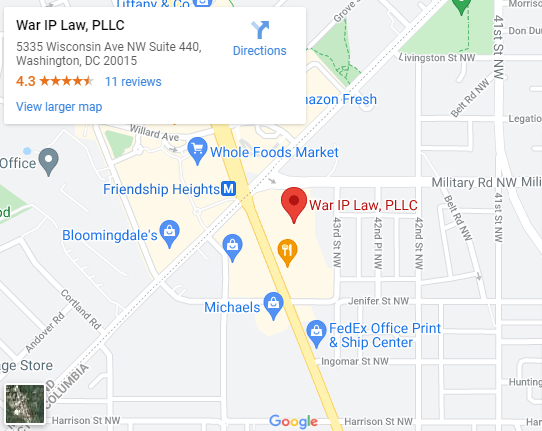What are the Challenges in Protecting AI-based Innovations and Intellectual Property?
Have you ever wondered about the challenges that arise when advanced Artificial Intelligence (AI) technologies clash with Intellectual Property (IP) laws? Disputes over ownership of AI-generated works and complex legal issues related to AI inventors can be common in such scenarios. To navigate the intersection of AI and Intellectual Property, seeking guidance from an experienced attorney becomes essential. As AI rapidly advances and reshapes industries, understanding how to protect AI-related intellectual property is crucial.
War IP Law is a law firm that handles Intellectual Property cases, and we are here to help protect your AI innovations. Our team of IP attorneys have extensive experience and a deep understanding of the ever-changing landscape of intellectual property law. We are fully prepared to handle the unique challenges that AI poses and its impact on intellectual property rights. Whether it’s copyrights, trademarks, patents, or trade secrets, we have the knowledge and skills to protect your valuable AI-related assets. You can trust War IP Law to be your strategic partner in securing and enforcing your intellectual property rights.
Don’t hesitate to contact War IP Law today. Our experienced attorneys are ready to discuss how we can assist you in navigating the complex world of AI and Intellectual Property. We will ensure that your innovations are protected, and your rights are safeguarded.
What is Artificial Intelligence (AI)?
Artificial intelligence refers to a system based on machines with the ability to make predictions, recommendations, or decisions that can affect either real or virtual environments. The main purpose of artificial intelligence is to achieve specific goals defined by humans.
What is Intellectual Property (IP)?
Intellectual property (IP) law revolves around safeguarding and preserving an individual’s exclusive rights to their intellectual property, creations, and inventions. It encompasses a wide range of areas, such as useful inventions, product designs, technology transfers, biotechnology, trade dress, computer software, and artistic works. Intellectual property rights are established when an inventor comes up with an original creation to prevent others from copying, stealing, or imitating their work. The main aim is to prevent piracy, unauthorized use, or counterfeiting of their valuable creations.
What are the Different Types of Intellectual Property Rights?
Intellectual property (IP) plays a crucial role in safeguarding innovative ideas, creations, and inventions. In the context of AI and intellectual property, understanding the key concepts is important. These intellectual property rights include:
- Copyright: Protects original works like literature, music, art, and software. It gives creators exclusive rights, such as controlling reproduction, distribution, and public display of their works. Registering works with the US Copyright Office offers additional legal benefits and remedies.
- Trademark: Protects brands and distinguishes the source of goods or services from others in the market. They can include names, logos, slogans, or unique product packaging. Registering trademarks with the United States Patent and Trademark Office provides legal protection against unauthorized use and helps prevent consumer confusion.
- Patent: Safeguards new inventions and technological advancements. They grant inventors exclusive rights for a limited time, preventing others from making, using, selling or importing the patented invention without permission. US patent law establishes criteria for patentability, including novelty, usefulness, and non-obviousness.
- Trade Secret: Encompasses confidential and valuable information like formulas, algorithms, customer lists, or manufacturing processes, which give a competitive edge. Trade secret protection is governed by federal laws like the Defend Trade Secrets Act (DTSA) and state-specific laws like the Uniform Trade Secrets Act (UTSA) adopted in Washington DC. These laws offer legal remedies against misappropriation and unauthorized disclosure.
By understanding the different types of intellectual property rights, individuals and businesses can effectively protecting their innovations, brands, and confidential information. This fosters a culture of innovation and encourages further advancements in the age of AI.
What are the Challenges in Protecting AI-based Innovations and Intellectual Property?
In the world of AI and intellectual property, various challenges arise when it comes to protecting AI-based innovations. These challenges include:
- AI-generated Inventions and Patentability: Determining inventorship and ownership of AI-generated inventions poses unique challenges. The current patent law in the United States (Title 35, U.S. Code) requires human inventorship. However, with AI’s involvement in the creative process, it raises important questions about the rightful individuals or entities behind AI-generated inventions.
- Novelty and Non-obviousness Requirements: For an AI-generated invention to be patentable, it must fulfill the criteria of novelty and non-obviousness. Assessing the novelty and non-obviousness of AI-generated inventions can be difficult since AI systems have access to vast amounts of existing data, enabling them to derive inventive solutions that may not be immediately apparent to human inventors.
Copyright Protection for AI-generated Works
- Concerns about Originality and Authorship: Copyright law protects original works of authorship. However, determining the originality and authorship of AI-generated works can be complex. We struggle with questions about whether AI systems can be considered the authors of creative outputs and the corresponding rights and ownership.
- Ownership of AI-generated Creative Outputs: Collaboration between human creators and AI systems often plays a role in producing AI-generated works. To determine ownership, we need to carefully consider the contributions made by both humans and AI, along with the applicable copyright laws and regulations.
Trademarks and AI Applications
- Assessing Trademark Distinctiveness and AI-generated Brands: Navigating AI’s impact on trademarks involves assessing the distinctiveness and protectability of AI-generated brands, requiring comprehensive analysis of consumer perception and strict adherence to trademark laws.
- Mitigating Consumer Confusion and Brand Dilution: To mitigate confusion and brand dilution from AI-generated content, it’s crucial to deploy tailored monitoring and enforcement strategies, ensuring that AI doesn’t infringe upon existing trademarks in our evolving digital landscape.
What are the Strategies for Managing AI and Intellectual Property?
In the rapidly changing world of AI and intellectual property, having effective strategies for protecting and managing AI innovations is crucial. These strategies can help safeguard intellectual property in the context of AI.
- Customizing IP Strategies for AI Innovations: To ensure maximum protection for AI innovations, it’s essential to tailor intellectual property strategies specifically for AI. This involves conducting thorough searches and analysis to ensure that your AI technology is unique and hasn’t already been patented. By filing patents for unique AI algorithms and methods, you may be able to establish legal protection for your AI innovations. It’s also important to consider the strategic use of trade secrets to protect proprietary AI models, allowing you to maintain exclusive ownership and control over valuable AI technologies.
- Addressing Ownership and Liability Issues: Navigating ownership and liability issues of AI-generated inventions is critical. Proactively establishing ownership agreements and allocating responsibilities within AI development teams can clarify rights, enhance accountability, and reduce disputes.
- Copyright Considerations for AI-generated Content: AI-generated content poses distinct copyright issues. Clear ownership guidelines for such content are vital. Defining copyright holders, creating licensing frameworks, and encouraging fair use can ensure lawful use while preserving intellectual property rights.
- Trademark Protection in the Age of AI: As AI-generated brands increase, so does the need for trademark protection. Evaluating these brands for trademark registration, assessing distinctiveness, and law compliance, along with online monitoring and enforcement, helps prevent unauthorized use and upholds brand integrity.
Call our AI And Intellectual Property Lawyer Now!
Facing challenges with AI and intellectual property? From handling ownership issues of AI-generated works and trademark infringements in the digital landscape, to determining patentability of AI inventions and safeguarding AI-focused trade secrets, the complexities of AI and IP law can be daunting. At War IP Law, our experienced attorneys are equipped to guide you through these complexities.
We offer tailored solutions for issues like trademark protection, patent eligibility, copyright infringement, and trade secret security. Don’t navigate this complicated terrain alone. Contact us today and schedule a review with our Washington, D.C. IP attorney.






